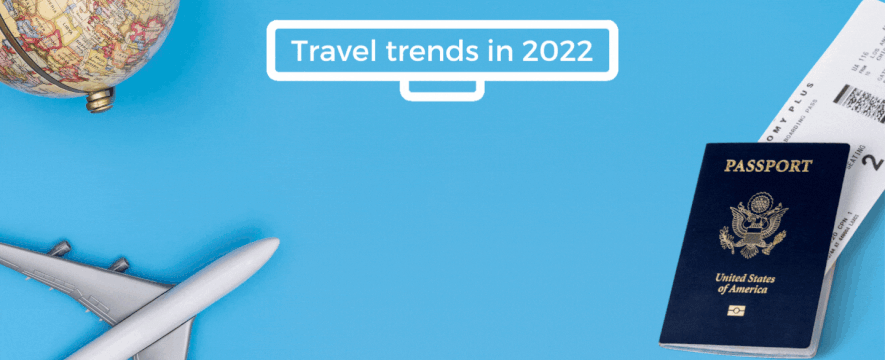Is pent-up demand real? What is the GOAT mindset? Is “trip stacking” still a thing? What does “spontechnaity” mean? We researched new travel trends in 2022 and learned how fast the trends among travelers are emerging lately, or better to say, how their mindset is changing, which leads to new trends.
If you want to make sure you will prepare your business to create and sell packages and itineraries that will actually be interesting and appealing to this evolved generation of customers, read further.
1. Small and private groups
According to the annual survey conducted by the United States Tour Operators Association (USTOA), and based on the existing customers’ bookings, small group tours will be the most popular travel product for 2022.
“FIT ranked second, followed by private groups, classic group tours (25+ passengers), river cruising, and small ship cruising”, reports USTOA.
“On small-group tours, your fellow travelers have been vetted for vaccine status, guides take care of all the tedious paperwork – and you can bring your friends. What’s not to like?” reports Explore Travel AU.
How to respond to the small and private groups trend
If your tour operating company already doesn’t offer products for small and private groups in your catalog, NOW is the time to expand your offer.
We’re aware it requires a lot of work and changes – new contracts with suppliers, different approaches to allotments, new calculations and pricing, and changes in your internal organization… But adjusting to the new trends is the only way to stay relevant on the market and survive the crisis.
Making the switch, however, is easier said than done, especially if your core business pre-Covid was FIT. And vice-versa, it is simpler to adjust the offer if your business already creates and sells products for large groups. Those need to be fine-tuned to accommodate fewer people.
In both cases, while making the switch in your back-end, you should also pay attention to the front-end. Final itineraries, to respond to the new generation of travelers, should look beautiful and modern. Moreover, if your company is digitalized, you should consider even more advanced formats, such as virtual reality tours. They’re also taking a huge rise in the current and upcoming trends. In their research and planning process, travelers want to preview the experience from the coziness of their home.
2. GOAT mindset
In their recent Travel Trends Report, Expedia polled 12 thousand travelers in 12 countries. One of the world’s leading OTAs coined the term GOAT – “Greatest of All Trips.”
Expedia calls this a “no-regrets” style of travel where travelers crave new experiences and seek sensation. We wrote about the rise of this trend in our 2021 travel trends blog when different resources called it ”once-in-a-lifetime trips”. A few months later, it even got its acronym which is getting more and more popular globally.
Regardless of how you call it, among all travel trends in 2022, this one is huge and should have the most substantial impact on travel companies who want to stay successful on the market.
That technology is key to successfully responding to travelers’ needs, states the report by booking.com too. They revealed that “more than half (55%) of travelers are excited about tech’s potential to further personalize their travel experiences in the near future”. They also coined a new term for this trend – “spontechnaity”. It means that tech will drive travel in the future and enable a more spontaneous, seamless customer experience.
How to respond to the GOAT trend
As our Head of Sales Iva Vodopija, stated in the article for Netokracija, to respond to these needs, tour operators also have to proactively work on their mindset change.
They have to let go of some old habits and replace time invested in outdated and repetitive parts of their processes with investment in understanding and fulfillment of ‘new generations’ expectations. It ultimately results in ensuring an excellent customer experience.
“Customer experience must become the focus instead of selling a specific product, and to do so, readiness to digitalize will increase even more in the coming years,” said Iva.
3. Pent-up demand and last-minute bookings
Pent-up demand is real, and it’s not the newest among travel trends in 2022. It has been showing its effects on the market for a while now. Generally, during the pandemic, most travelers don’t travel to a destination only if its government doesn’t allow them. As soon as the governments lift restrictions, travel companies get flooded with queries and bookings. This trend has been going on and off for nearly two years now, and predictions say it will stay.
In their 2022 outlook, one of the leading providers of travel data and insights, ForwardKeys, takes an example of Greece. In March 2021, the government announced a reopening to travelers with a Covid certificate.
“At the very same time, the number of covid cases in Greece was rising at an alarming rate. (…) It is fair to assume that people knew about this situation and yet, the number of international tickets to the country grew at a very fast pace, which made Greece one of the success stories of last summer.” reports ForwardKeys.
How to respond to pent-up demand
From this trend, we learned that even during the highest peaks of the Covid-19 pandemic, people still want and will travel. Therefore, tour operators need to be ready. Making sure they get alerts 24/7 on their residential government’s decisions is important, as it directly and instantly impacts their business.
And each time the borders are open and restrictions eased, they need to be ready by all means to serve the pent-up demand. And again, without technology and digitalization, this is hardly possible. The probability of making a mistake – which leads to losing both money and happy customers – is pretty high, when you don’t have a system that automates calculations, instantly updates availability and bookings, and prevents overbooking.
4. Trip stacking
This trend took a huge rise in autumn 2021. Travelers then found a “loophole” in the system thanks to the free or flexible cancellation policies which most travel companies introduced during the pandemic.
Basically, travel lovers realized they could book a few trips, for the same period or back-to-back, to different destinations, in case some of them revert to heavy restrictions and forbid travel. They could cancel those for free and stick to the destination that still allows travel.
“In short, trip stacking boils down to hedging your travel bets,” reports Forbes.
How to respond to the trip stacking trend
As great as it is for travelers to have backup options in the pipeline, it is a nightmare for tour operators and travel agencies that are not technically ready to support this “mess” during the ever-changing times. Hundreds of booking changes with no guarantee they will actually be carried out and paid, endless delays and cancellations… It implies A LOT of operational work in times when the majority of travel companies reduced their number of staff. It also has consequences on the supplier chain and pricing, which is also hard to manage if the business doesn’t have a digital solution to support this.
Here’s a visual representation of the difference between a tour operator that hasn’t digitalized and automated their business processes with the help of a software solution and the one that uses Lemax:
In short – 2/3 of resources can be saved and re-focused on managing more essential activities.
5. Mobile experience
Technically, this is not one of the new travel trends in 2022. It’s been a while now that smartphones have evolved to a meta media. In the last decade, people have gotten used to having more and more brands and services adjusting to this trend and optimizing for mobile experiences. But especially during the pandemic, this trend rose rapidly.
Hence, it’s a no-brainer for every travel business to adopt this trend. Harnessing the power of technology in order to serve the needs of the customer is the way to go.
Many resources report on the huge spike in mobile bookings in all segments of the industry in the last year. We’ll single out one from Arival. It surveyed 1.000 US travelers to learn how they are planning and booking amusement park visits in 2021-2022. It has shown that direct mobile bookings are on the big rise compared with just two years before:

How to respond to the mobile booking trend
Having a website that is optimized for a mobile experience is the first step you need to take. Ideally, if your business is B2C, both desktop and mobile versions will support the end-to-end customer journey. This includes browsing the internet, finding your website, seamlessly browsing your offering, communication, and final booking.
Once you have the technical setup sorted, you can start working out some more advanced initiatives. These will both make you stand out from your competition and be customer-friendly. For example mobile-only offers (discounted if customers buy on their phones), mobile notifications for important updates, and so many more features that already exist in other industries and areas of every-day-life of travelers.



